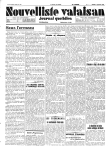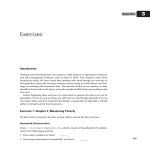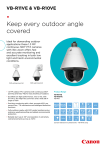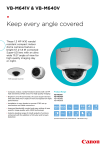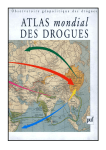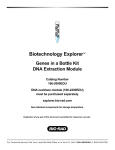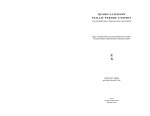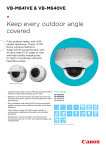Download DEB-IBM User Manual
Transcript
1 DEB-IBM User Manual Dynamic Energy Budget theory meets individualbased modelling: a generic and accessible implementation Benjamin Martin1*, Elke Zimmer2, Volker Grimm1, Tjalling Jager2 Dept. of Ecological Modelling, Helmholtz Center for Environmental Research – UFZ, Permoserstrasse 15, 04318, Leipzig, Germany 2 Dept. of Theoretical Biology, Vrije Universiteit, de Boelelaan 1085, NL-1081 HV, Amsterdam, the Netherland 1 This manual explains how to use the model DEB-IBM, which is a NetLogo implementation of a generic individual-based model based on Dynamic Energy Budget (DEB) theory. It also gives a quick overview of DEB theory and its basic parameters. The rationale of the model and its implementation are also explained in: Martin B, Zimmer E, Grimm V, Jager T. Year. Dynamic Energy Budget theory meets individual-based modelling: a generic and accessible implementation. Journal Volume: pages. The NetLogo implementation and the complete model description following the ODD protocol can be found here: NetLogo implementation. ODD model description. We recommend reading the article and the ODD model description first. 2 Leipzig – Amsterdam December, 2010 * Corresponding author, email: [email protected] 3 Contents 1. Getting Started ......................................................................................................... 4 1.1 About NetLogo ................................................................................................... 4 1.2 About DEB............................................................................................................ 4 1.3 Installation............................................................................................................ 4 1.4 How to use the model ....................................................................................... 5 2. DEB parameters ........................................................................................................ 6 2.1 DEB notation........................................................................................................ 6 2.2 Standard DEB parameters................................................................................. 7 2.2.1 Feeding and assimilation related parameters: {F&m } , {J& EAm } , yEX ............. 8 2.2.2 Reserve dynamics parameters: κ, v& ........................................................ 9 2.2.3 Somatic growth and maintenance parameters: {J& ET } , [ J& EM ] , yVE ....... 9 2.2.4 Development and reproduction parameters: M Hb , M Hp , k&J , κR .......... 10 2.3 Standard DEB can be expressed in mass or energy ................................... 10 2.4 From standard to compound parameters ................................................... 11 2.5 From standard DEB to scaled DEB ................................................................. 12 2.6 DEB-IBM parameters......................................................................................... 14 3. The interface ........................................................................................................... 14 3.1 Running the basic model ................................................................................ 15 3.2 Optional submodels ......................................................................................... 15 3.2.1 Add my pet parameters........................................................................... 15 3.2.2 Food dynamics........................................................................................... 17 3.2.3 Ageing ......................................................................................................... 17 3.2.4 Stochasticity................................................................................................ 18 3.3 Plots, Histograms and Monitors ....................................................................... 18 4. Procedures ............................................................................................................. 19 4.1 Basic code structure ........................................................................................ 19 4.2. Guide for adapting the model ..................................................................... 20 4.2.1 Feeding ....................................................................................................... 21 4.2.2 Reproduction ............................................................................................. 21 4.2.3 Starvation .................................................................................................... 24 4.2.4 Spatial dynamics........................................................................................ 26 4 1. Getting Started This manual describes how to install and use the model DEB-IBM, a generic individual-based model that includes general DEB theory as a submodel for the individuals’ bioenergetics and life-cycle. The main task of users of DEB-IBM will be to parameterize the model and to possibly revise the underlying NetLogo program. In this manual we therefore first explain the DEB parameters used in DEB-IBM and then give examples for how to revise the code. The overall purpose of this model and its implementation are explained in Martin et al. (Year), whereas the model itself is described using the ODD protocol for describing individual-based models (Grimm et al. 2006, 2010) is available at ODD website. 1.1 About NetLogo The model is implemented in NetLogo, version 4.1.1 (Wilensky 1999). NetLogo is a software platform specifically designed for implementing individual-based and agent-based models. It includes powerful “primitives” (procedures) that allow users to implement even relatively complex models with relatively few lines of code and little or no previous programming experience. Complete novices to NetLogo and programming can generally program efficiently in 23 days; two textbooks on individual-/agent-based modelling are in press (Railsback and Grimm, in press1; Wilensky and Rand, in press). 1.2 About DEB Dynamic Energy Budget theory (DEB theory, Kooijman 2010) provides a set of rules that specifies the acquisition and use of energy in an organism, and thereby the life-history traits for the whole life-cycle of a single organism. More information about DEB can be found on http://www.bio.vu.nl/thb/. By using the Individual Based Model (IBM) as implemented in NetLogo, it is possible to investigate the population dynamics of a species, following DEB theory, by inputting the specific metabolic, (DEB) parameters for the species of interest. A continuously growing library of DEB parameters for all kinds of different species can be found on the above mentioned homepage, in the DEB laboratory (see add_my_pet parameter section below ). 1.3 Installation NetLogo is free software and can be downloaded from: 1 See also www.railsback-grimm-abm-book.com 5 http://ccl.northwestern.edu/netlogo/; versions for the operation systems Windows, MacOS, and Linux are available. Installation is straightforward and usually does not take more than five minutes. To run and use the model DEBIBM, start NetLogo and open “DEB-IBM.nlogo” (which comes with the DEB-IBM package that be downloaded from DEB-IBM webpage. 1.4 How to use the model NetLogo comes with three tabs: interface, information, and procedures. The “interface” tab is where users can input the DEB parameters of their species, alter environmental variables, and observe individual and population level output of the model. The “procedures” tab contains the NetLogo program, or code, implementing the DEB-IBM model. Here users can alter model structure, create new variables to monitor, add procedures for file output, and include other aspects of importance to the population dynamic of their species such as behaviour, space, and predation. There are two levels of use for DEB-IBM. The first requires only familiarity with the interface. On the interface users can input the DEB parameters of their species and observe various population and individual variables such as population density, size structure, and reserve levels under various feeding conditions (data of all diagrams can be exported via the diagrams’ context menus or NetLogo’s “export” primitives). This level of use requires no programming. All information that users need to use the model are the DEB parameters of their species of interest. Thus, at this level the program allows users to learn how changes in metabolic parameters alter characteristics of individual life-histories and population dynamics. The second level of using DEB-IBM is modifying the generic program to answer specific research questions or to adapt the model to specific species. For example, a researcher may be interested in how the population dynamics of a species is influenced by changes in land use. In this case the researcher would adapt the standard model to include space and movement behaviour of individuals, with the DEB theory acting as the energetic model. This more engaged use of the model requires users to be familiar with both the interface and procedure tabs. Likewise, species may show specific behaviours that are not captured by DEB theory; these behaviours could be added to the generic model. For this second level of using DEB-IBM, basic training in modelling and NetLogo are required. Beginners in both fields would need obtaining some literacy in both fields, for example by using the textbook of Railsback and Grimm (in press). 6 2. DEB parameters Our implementation of the DEB-IBM is based on the scaled DEB model (Kooijman et al. 2008) and uses compound parameters. These compound parameters are derived from the 12 primary parameters of the standard DEB model. Implementing our model in the scaled version of DEB rather than the standard DEB model further simplifies the model: by dividing the state variables “reserve”, “maturity”, and “reproduction” by the maximum surfacearea-specific assimilation rate, one parameter of the standard model is removed as well as the unit of either energy or mass (standard DEB can be based in either) from the model. Working with the scaled DEB model with compound parameters allows parameterizing the DEB model for a species without directly measuring energy or mass (you cannot estimate energy parameters without measuring energies). See Kooijman et al. 2008 for a guide for parameterizing a DEB model. While the general principles of DEB theory are relatively simple, the formulas used in our implementation have been algebraically rearranged, reduced (using compound parameters), and scaled. Thus the resulting formulas used in DEB-IBM may not seem intuitive. For a novice to DEB theory it may be difficult to understand what processes are actually driving fluxes for each of the DEB state variables. To facilitate a better understanding of DEB theory for those interested in population dynamic applications we below provide a brief introduction to the standard DEB parameters, how the compound parameters used in DEB-IBM relate to these parameters, and how changes in the each of the parameters effects the life-history of the modelled individuals. In addition to this user manual and the ODD model description, we recommend those new to DEB theory to first read (http://www.bio.vu.nl/thb/deb/index.html) for a non-technical introduction to the concepts of DEB theory and Kooijman et al. (2008) and Kooijman (2010) for a more formal description. For those already familiar with compound parameters and the scaled DEB model this section can be skipped. 2.1 DEB notation In all text (manuscript, ODD model description, and user manual) we used standard DEB notation. This notation may look somewhat cumbersome at the beginning, but has a long history and is, by itself, highly consistent. Therefore, careful attention to the notation will spare users considerable time and confusion. We recommend routinely using Table 1 in the ODD model description, which contains a comprehensive list of all parameters dealt with in both the text and in the implementation of the model. 7 Quantities that are expressed as unit per structural volume are surrounded with “[ ]”, for example [ J& EM ] is maintenance rate per unit of volume, while a symbol enclosed in “{ }” indicates a quantity that is expressed per unit of surface area; for example {J& EAm } is the surface-area-specific maximum assimilation rate. The dots above J in {J& EAm } , [ J& EM ] , and all other symbols indicate that the quantity is a rate per unit of time. Because the use of DEB notation is not possible within the code of NetLogo we have to convert the notation into a code-compatible notation. The names of the parameters are given corresponding to the standard DEB notation as follows: a rate, which is in standard DEB identified by a dot above the letter, is here identified with the extension “_rate”, For instance, energy conductance, ν& , is called “v_rate_int”. The “_int” portion refers to the fact that these are the initial, or baseline, parameters for a species. Users can allow individuals to vary in their DEB parameters from the initial parameters in some way, as we do for four of the DEB parameters (see stochasticity section below). Subscripts and superscripts in DEB notation are indicated by “_” and “ ^ ”, respectively. Although NetLogo is not case sensitive we keep cases consistent with DEB notation (Kooijman 2010). When a DEB parameter contains both a super and subscript the subscript goes first. For instance, scaled maturity at birth, U Hb , is written “U_H^b_int”. 2.2 Standard DEB parameters The most basic version of the model can be run with just defining the eight scaled DEB parameters in the left column of input fields on the interface (Fig. 1). The “scaled” version of DEB is a simplification of the standard DEB model, which uses compound parameters that are functions of standard DEB primary parameters. These compound parameters are often easier to extract from the data (Kooijman et al. 2008). Below we first provide a brief description of each of the 12 standard DEB parameters and then how these parameters are transformed to the scaled parameter set. Figure 1. Input fields for the eight scaled DEB parameters used by default in DEB-IBM (screenshot taken from the NetLogo program). Differences between species are primarily represented by these values. 8 Table 1. The 12 primary DEB parameters (in dimension of mass) and their associated processes. Standard DEB Parameters Symbol Unit Description Process m3d-1m-2 surface-area-specific searching rate Feeding/assimilation {J& EAm } mol d-1m-2 surface-area-specific maximum assimilation Feeding/assimilation rate yEX mol mol-1 yield of reserve on food Feeding/assimilation v& m d-1 energy conductance Reserve dynamics κ - allocation fraction Reserve dynamics yVE mol mol-1 yield of structure on reserve {J& ET } mol d-1m-2 surface-area-specific somatic maintenance [ J& EM ] mol d-1m-3 volume-specific somatic maintenance M Hb mol maturity at birth M Hp mol maturity at puberty k&J d-1 specific maturity maintenance κR - reproduction efficiency {F&m } 2.2.1 Feeding and assimilation related parameters: somatic growth/maintenance somatic growth/maintenance somatic growth/maintenance reproduction/development reproduction/development reproduction/development reproduction/development {F&m } , {J& EAm } , yEX The surface-area-specific searching rate, {F&m } , influences the functional response for a given prey type. Earlier versions of DEB used the half saturation coefficient, K, which relates to {F&m } via K = {J& EAm } / [yEX {F&m } ]. Here yEX is the yield of reserves on food or, in other words, the conversion efficiency of moles of food into moles of reserve; in most bioenergetic models this is referred to as assimilation efficiency. Dividing the surface-area-specific maximum assimilation rate, {J& EAm } , this conversion efficiency gives you the surface-areaspecific maximum ingestion rate, {J& XAm } . The ratio between the maximum surface-area-specific ingestion rate and the surface-area-specific searching rate, {F&m } , gives you the half saturation coefficient (K) in a Holling type II functional response (this response follows from the assumption that the full time budget of an organism is spent either searching or handling food). In recent formulations of DEB theory {F&m } has replaced K as a primary parameter in the standard DEB model because it is more closely linked to the underlying 9 mechanism. For more mechanistic details and reasoning behind the feeding process see Kooijman (2010, p. 25). 2.2.2 Reserve dynamics parameters: κ, v& In DEB theory, assimilated energy first enters a reserve before mobilized for somatic or development and reproduction purposes. One of the assumptions of DEB theory is “weak homeostasis”, which means that at a constant food density the ratio of reserves to structure remains constant. The derivation of reserve dynamics from this assumption is rather complex and explained in Kooijman (2010, p. 37). In a simplified case of an organism which does not grow, for reserve density to remain constant assimilation would have to equal mobilization. However, for growing organisms mobilization must be lower than assimilation due to dilution of reserve density via growth. The dynamics resulting from the assumption of weak homeostasis is that mobilization of reserves will be proportional to reserve density, with the proportionality constant depending on the ratio of energy conductance, v& , and the length of the individual. Higher values of energy conductance imply a lower resistance of transfer from reserves to structure along the reserve-structure interface, thus the higher the conductance, the faster reserves are depleted and mobilized for use. The maximum reserve density [EM] is given by the maximum surface-area-specific assimilation rate, {J& EAm } , and energy conductance, v& . The allocation fraction parameter, “kappa”, κ, is the fraction of mobilized reserves which is allocated to somatic growth and maintenance, while the remainder, (1 – κ), is allocated to development and reproduction. 2.2.3 Somatic growth and maintenance parameters: {J& ET } , [ J& EM ] , yVE The fraction κ of mobilized reserves is allocated to the soma, i.e. the nonreproductive parts of the organism. In the soma, maintenance costs are paid first and the remaining energy is allocated to growth. There are two basic categories of maintenance costs, those which are surface-area-specific and those which are volume-specific. Surface-area-specific costs typically relate to heat loss of endotherms, but can also represent other surface-area-related costs such as osmoregulation. In the current implementation of the model we focus on ectotherms and we assume surface-area-specific costs to be negligible, i.e. {J& ET } = 0. Volume-specific maintenance rate [ J& EM ] represents the costs associated with maintaining and implementing somatic functions (maintaining concentration gradients, turnover of structure, movement). Because this is a volume-specific rate, volume-related maintenance costs of a certain individual are obtained by multiplying [ J& EM ] by the individual’s volume, or structural length cubed, L3 Thus, in the absence of surface-area-related 10 costs, an individual two times larger in volume or weight would have double the daily maintenance costs. The remaining mobilized energy is converted to growth, with an efficiency of yVE, or in other words how many moles of structure are produced from one mol of reserve. Usually, in DEB theory we consider structure in units of volumetric length, which is L = V1/3 (see Kooijman 2010 p. 10, for explanation structural (volumetric) length in comparison to measured physical length).. To convert moles of structure into volume, L 3, or volumetric length, L, we use [MV] which converts moles to cubic centimetres; a typical value for this parameter is 4 mmol cm-3 (Kooijman 2010). 2.2.4 Development and reproduction parameters: M Hb , M Hp , k&J , κR The fraction of mobilized energy not allocated to the soma, (1–κ), is allocated to development or reproduction. DEB theory divides the life history of all species into three classes: embryos, juveniles, and adults. Embryos do not feed externally but use maternal reserves for growth and development (at “conception” an embryo is composed of nearly only reserves). A transition from embryo to juvenile marks a switch to exogenous feeding. Neither embryos nor juveniles reproduce. The transition from juvenile to adult marks the start of investment into reproduction (the actual reproduction may occur a little later). In DEB theory these two transitions are made after a given amount of mobilized energy, M Hb , has been allocated to maturity to transition from embryo to juvenile, and M Hp to transition from juvenile to adult. Unlike structure, maturity has no mass or dimensions but rather is considered “information” (maturity is quantified by the cumulative amount of reserves invested in it). Like for soma, individuals must pay costs associated with maintaining a given level of maturity. These costs are taken proportional to the maturity level (in mol of invested reserves); the proportionality constant is the maintenance rate coefficient, k&J , with the units of d-1. Total energy spent on maintaining maturity is proportional to maturity level. When individuals reach puberty, at MH = M Hp , maturation is complete and M Hp represents a maximum value of maturity. Once an individual reaches puberty, energy remaining after maintenance costs for maturity are paid are allocated into a reproduction buffer. The reproduction buffer is depleted during reproduction (the creation of offspring) and is converted into embryonic reserves (embryos are nearly 100% reserves) with an efficiency equal to κR. 2.3 Standard DEB can be expressed in mass or energy Seven of the 12 standard DEB parameters shown in Table 1 are expressed in dimension of mass (mol). However DEB can also be expressed in the 11 dimension of energy (Joules). In this case, different notation is used for those seven DEB parameters (Table 2). Table 2. The parameters and units of the energy- or mass-specific parameters in standard DEB. The five standard parameters not listed are not specific to either energy or mass (Table 1). A typical value to convert between energy and mass is 550 kJ mol-1, and mass can be converted to volume via [Mv] (Section 2.2.3) with a typical value of 4 mmol cm-3 (Kooijman 2010). Standard Parameters in mass and energy Mass (moles) Symbol Unit Energy (Joules) Symbol Unit {J& EAm } mol d-1m-2 { p& Am } yEX mol mol-1 κX yVE mol mol-1 [ EG ] J m-3 {J& ET } mol d-1m-2 { p& T } J d-1m-2 [ J EM ] mol d-1m-3 [ p& M ] J d-1m-3 J d-1m-2 - (assimilation ciency) M Hb mol E Hb J M Hp mol E Hp J effi- Table 3. Symbols used for the state variables in the dimensions of mass and energy, and in the dimensionless scaled DEB used in DEB-IBM. DEB state variables State variable Mass Energy Length L L ME EE Reserves Scaled L UE Maturity MH EH UH reproduction buffer MR ER UR 2.4 From standard to compound parameters As mentioned earlier it is often convenient to work with compound parameters as they require less data to parameterize. These compound parameters represent combinations of primary parameters that are grouped together in the differential equations for the standard DEB model. In the current implementation we used two compound parameters: energy investment ratio, g, and specific somatic maintenance rate, k&M . The former, g, is derived from the standard primary parameters using units of mass: g= [ M V ] v& κ {J& EAm } yVE 12 or energy: g= [ EG ] v& . κ { p& Am } Because maximum reserve density [ EM ] = { p& Am } , v& we can think of g as the cost to create a unit of structure relative to the maximum reserve density which would be allocated to the soma: g= k&M [ EG ] κ [ EM ] is derived from the standard parameters using units of mass: [ J& ] y k&M = EM VE [M V ] or energy [ p& ] k&M = M [ EG ] The reason why we see [ M V ] in the formulas for g and k&M in the mass parameterization and not in the energy parameterization of the standard DEB model is that [ EG ] converts energy in reserves to growth in the dimension of length, while yVE converts moles of reserves to moles of structure and [ M V ] is needed to convert to structural length. 2.5 From standard DEB to scaled DEB Using the two compound parameters g and k&M in place of the primary parameters we get a simplified version of the standard DEB differential equations for reserves: ( d M E = {J& EAm } f L2 − J& EC dt ) with ge ⎛ Lk& ⎞ ⎜1 + M ⎟ J& EC = {J& EAm }L2 ⎜ g +e⎝ v& ⎟⎠ 13 and e=v v&M E L3{J& EAm } . e is the scaled reserve density; the “scaled” is in reference to the amount of reserves per unit of structure (reserve density) relative to the maximum amount of reserves per unit of structure. Remembering that maximum reserve density [ EM ] = {J& EAm } v& we see that e is the total mass of the reserves divided by volume and maximum reserve density and will have a value between 0 and 1. The changes in DEB’s three state variables (Table 3), length, maturity, and reproduction buffer can then be calculated as follows: ( ) ⎛ κJ& − [ J& EM ]L3 yVE d L = ⎜⎜ EC [MV ] dt ⎝ ⎞ ⎟ ⎟ ⎠ 1 3 d M H = ((1 − κ ) J& EC − k&J M H ) for M H < M Hp else d M H = 0 dt dt d d M R = ((1 − κ ) J& EC − k&J M Hp ) for M H > M Hp else MR = 0 . dt dt As we mentioned earlier our model is implemented in the scaled version of DEB. By this we mean that to remove the unit mol (or Joule if using the energy parameterization of DEB) we divide all state variables in moles (ME, MH, and MR) by the maximum surface-area-specific assimilation rate {J& EAm } (or { p& Am } if working with energy) to get scaled reserve UE , scaled maturity UH, and scaled reproduction buffer UR (Table 3). Dividing both sides of the three differential equations by {J& EAm } gives: d U E = ( fL2 − SC ) dt With SC = L2 ge ⎛ Lk&M ⎞ ⎟ ⎜1 + g + e ⎜⎝ v& ⎟⎠ d U H = ((1 − κ ) SC − k&J U H ) for U H < U Hp else d U H = 0 dt dt d d U R = ((1 − κ ) SC − k&J U Hp ) for U H > U Hp else U R = 0 . dt dt 14 Notice that we now use scaled U Hp and U Hb for parameters related to lifestage transitions, which are equal to M Hp and M Hp divided by {J& EAm } . The length dynamics simplify to: d L= dt ⎞ 1 ⎛ v& ⎜⎜ SC − k&M L ⎟⎟ . 2 3 ⎝ gL ⎠ 2.6 DEB-IBM parameters We have now derived the equations used in DEB-IBM. If food conditions are Figure 2. The interface of DEB-IBM. Elements of the Interface are buttons (e.g., setup), input fields (e.g., E_H_b), sliders (e.g., timestep), choosers (e.g., aging), monitors (e.g., count turtles), and plots (e.g., population density). constant we only need eight parameters to run simulations. To run DEB-IBM at constant food conditions, set the “food-dynamics” chooser to “constant” and set scaled assimilation rate to the desired value. The input boxes for the eight parameters needed to run DEB-IBM at constant food conditions are on the left-most side of the interface (Fig. 1). The bottom four parameters in the column are primary DEB parameters ( v& ,κ, κ R, and k&J ). The top four parameters include the two compound parameters g and k&M , in addition to the two lifestage transition parameters, U Hb and U Hp . 3. The interface In Fig. 2, you see how the interface looks like after opening the model in NetLogo. 15 3.1 Running the basic model The first thing you should know is how to run the model. In Fig. 3, you see the most important buttons on the interface: The “setup” and “go” buttons. By pressing the “setup” button, you initialize the system, for instance, individuals are created and Figure 3. These buttons are needed to run the model obtain values for their state variables, for example their DEB parameters. By pressing the “go“ button, the simulation starts; the simulation will run until you press “go” again. (Pressing “go-once” makes the program execute one timestep.) In the current implementation of the model the parameters for a species are set for individuals during the setup procedure. Thus altering a parameter value in the interface will not result in a change in the DEB individuals’ parameter values unless the setup procedure is run after the changes were made. This could be altered to allow “midsimulation” modification of parameter values. In the basic version of the model, all of the standard DEB parameters are derived from the “Add my pet” database for the water flea Daphnia magna, (http://www.bio.vu.nl/thb/deb/deblab/add_my_pet/index.php). The timestep slider allows the user to control the timestep. The value selected on the slider bar represents how many timesteps a day is divided into. Thus all of the DEB parameters which are input into the model should be daily rates. Because the model is a discrete implementation of differential equations (Euler method), the timestep needs to be small enough for the equations to function properly. How small a timestep needs to be is dependent on the parameter values of a species. Fast-growing species need shorter time steps. 3.2 Optional submodels 3.2.1 Add my pet parameters A growing database of parameter sets for species can be found at: http://www.bio.vu.nl/thb/deb/deblab. The parameter sets contained in the “add my pet” database are the primary DEB parameters in energy. Thus we need to convert the primary DEB parameters from the add_my_pet database to those used in our implementation. On the interface of DEB-IBM are input boxes for five add_my_pet parameters (Fig. 4). By selecting “on” in the “add_my_pet” chooser and clicking the setup button, DEB-IBM automatically converts these five add_my_pet parameters to the four DEB-IBM parameters at the top of the scaled DEB-IBM parameters column (Fig. 1). The bottom four are primary DEB parameters require no conversion from those listed in the add_my pet database. The code for the conversion is in the procedure “con- 16 vert-parameters” within the “setup” procedure. In the following paragraph, we explain how these parameters are calculated. Noticeably missing from the Figure 4. The four top add_my_ pet database is the maximum parameters in Fig 1. surface-area-specific assimilation can be calculated parameter, { p Am } . This is because { p Am } is from these five pafood type specific. Some food types are of higher energetic value than others and thus organisms raised on ad-libidum concentrations of varying quality food can assimilate, and thus grow at different rates. However, we can use the “zoom” factor to estimate the value of { p Am } . The rameters given in the “add my pet” database. zoom factor is the maximum volumetric length, LM, of an organism in centimetres. It is called the zoom factor because DEB theory makes several predictions for scaling of DEB parameters interspecifically with body size, and the scaling of these parameters leads to many observable covariations such as growth rate, respiration, and life span (van der Meer 2006; Kooijman 2010, chapter 8). In DEB theory maximum length is a function of three primary parameters: maximum assimilation rate, kappa, and volume-specific maintenance costs. LM = κ { p& Am } . [ p& M ] Because add_my_pet gives values for all the parameters in this equation other than { p Am } , we can rearrange the formula to determine its value. Once the value of { p Am } is determined, all other conversions are straightforward. For U Hb and U Hp , we need to convert maturation threshold for birth and puberty to scaled maturity at birth and puberty by dividing by the surfacearea-specific maximum assimilation rate: U Hb = E Hb /{ p Am } And U Hp = E Hp /{ p Am } where { p Am } = [ p& M ]z κ For the two compound parameters we just use the formulas consisting of primary DEB parameters: [ p& ] k&M = M and [ EG ] g= [ EG ]v& { p& Am }κ 17 3.2.2 Food dynamics In the basic version of the model, the Figure 5. Feedscaled functional response, f , (f_scaled ing- related pain DEB-IBM) is set to 1 (ad-libidum feeding rameters as seen conditions). Keeping the food-dynamics on the interface. constant, you can change the food In the “fooddynamics” supply by changing f_scaled on the chooser, “conslider. This can be done while the model stant” or “logisis running without a new setup. tic” can be seIf you want to simulate a scenario l t d with a dynamic food source, you can change the food-dynamics to “logistic” (just click on it). In the built-in scenario, a logistically growing prey population is depleted by the DEB population via predation. This is a very simple scenario, and it may be more realistic to let the DEB animal feed on another DEB organisms but this is too specific for this implementation. For “logistic” prey dynamics, two new parameters are needed for the DEB individuals {J& XAm } and {FM } . {FM } is a primary DEB state variable for maximum surface-area-specific search rate and {J& XAm } is maximum surface-area-specific ingestion rate. {J& XAm } differs from {J& EAm } in that the latter only considers assimilated energy or {J& EAm } = {J& XAm } yEX . The prey population is characterized by the state variable density, X, and two parameters describing population growth rate, r, and carrying capacity K , respectively. For details see the prey dynamics submodel in the ODD model description. In the default model we assume feeding takes place in a three-dimensional environment (e.g. aquatic filter-feeders). However this can be modified to model feeding over two-dimensional surfaces. The parameter “volume” represents the size of the environment. The feeding submodel is only connected to the standard DEB model via the dimensionless scaled assimilation rate, f. Therefore, the units of X and volume can be userdefined (e.g. energy liter-1, mg cm-3, cells per mm-3) as long as they are consistent with each other. 3.2.3 Ageing In the basic version of the model, the ageing submodel is turned “on”. Individual’s age as described in Kooijman (2010) and the ageing submodel section of the ODD. If the ageing submodel is turned off, animals have a daily background mortality rate. Figure 6. Parameters as seen on the interface which affect the ageing submodel. 18 3.2.4 Stochasticity In the standard DEB model the only Figure 7. parameter which controls the inherent coefficient of variasource of stochasticity comes from the tion. If set to 0, there ageing is no intraspecific submodel. This can lead to extreme variation in DEB papopulation fluctuations because life-histories are exactly the same for all individuals which leads to synchronisation. One likely reason natural systems do not always exhibit such drastic fluctuations is that stochastic processes and heterogeneity among individuals prevent strong synchronization of life histories. One way of incorporating stochasticity is to allow individuals to vary in some of their DEB parameters. This method is justified because experiments often find that repeated physiological measurements of individuals are less variable then those between individuals. We followed the method outlined in Kooijman (1989) where individuals have a random component in the maximum surface-area-specific ingestion rate, {J& EAm } . In our implementation of the scaled DEB model there is no parameter {J& EAm } because we scaled it out of our model, but changing {J& EAm } affects other parameter values indirectly. Both values of the life-stage transition parameters will be affected because they are both scaled by {J& EAm } . The maximum surface-area-specific ingestion rate will be influenced {J& XAm } = {J& EAm } /yEV , which further influences the half-saturation coefficient K as K = {J& EAm } / [yEX {F&m } ], and finally it affects g as {J& EAm } is in the denominator of this formulation. Thus, variation in all of these parameters is included by multiplying (for & {J XAm } ) or dividing (for g, U Hb , and U Hp ) by a “scatter-multiplier” which is a lognormally distributed number with user-defined standard deviation “cv”. Users can select the value of cv in the “cv” input box. Entering a value of 0 results in all individuals having the same parameters. Obviously there are many other sources of stochasticity in natural systems. However the sources of stochasticity to be included in the model are likely to be system-specific and should be carefully considered by the researcher. 3.3 Plots, Histograms and Monitors In the default model we include several output plots and histograms to monitor the population dynamics of the modelled species. A plot of the population density, a plot of their prey density, and a plot of the stage class density with the x axis in days (embryo, juvenile, and adult). Additionally there are three histograms, i.e. the frequency distribution of length, L, and scaled 19 reserve density, e, for both juveniles and adults. Ultimately the user can record and plot any individual- or population-level variable of interest. For information on generating output data, plots, monitors, and histograms, see the NetLogo User manual and programming guide. Figure 8. The three default plots and three histograms displayed on the DEB-IBM interface. The plot “stage class density” shows the density of each life stage (embryo, juvenile, and adult) over time. The plots “food density” and “population density” show the density of the food (X) and total population. The “size distribution” histogram shows the distribution of lengths (L) of the population. The histograms “juv e distribution” and “adult e distribution” give the distribution of scaled reserve density (e) of juveniles and adults. 4. Procedures In this tab the structure of the model can be modified and other aspects relevant to population dynamics can be included. Here we discuss the basic structure of the code and suggest how to modify it. 4.1 Basic code structure The first section of the code declares the variables and specifies which type of variables they are. DEB individuals are referred to as “turtles", which is the NetLogo term for “agent” or “individual”. Turtle variables are state variables characterizing the state of a certain turtle, i.e. L, UE and UH. Additionally, 20 because we allow some of the DEB parameters to differ between individuals, we made the entire set of DEB parameters turtle variables (Grimm et al. 2010). In NetLogo, the spatial arena consists of square grid cells, called patches. The default model is non-spatial and therefore consists of only one patch (updating the view of the model world, or “view”, is therefore deactivated in the program). Patch variables are the state variables of a patch. In our model the density of prey is a patch variable. This allows to easily make the model spatially explicit by defining a grid of patches, each with their own states, e.g. prey and turtle density. Local predator-prey interactions are then easy to include, e.g. feeding of DEB predators on a patch only reduces the prey density on that patch. Finally, global variables are typically parameters which can be used by either turtles or patches. Globals can either be declared in the procedures tab or created on the interface tab, in which case they are not declared in the “globals-own[]”.The DEB parameters which do not vary between individuals could have been made global variables but we chose to make them turtle variables so that users could allow individuals to vary in any DEB parameter with little programming effort. Note that on the interface, you can only use global variables, no turtle or patch variables. Therefore, all eight DEB parameters on the interface (Fig. 1) are distinguished from the turtles variables by the suffix “_int”; four of these parameters are then made to vary between individuals (see section 3.2.4). The remainder of the code includes two major procedures: setup and go. The setup procedure involves all processes required to initialize the model. In the setup procedure some initial individuals are created and their state variables and parameters are specified. A detailed description of the initialization is given in the ODD model description. The go procedure runs the population model. An overview of the model processes and their scheduling and a detailed description of each submodel are given in the ODD model description. 4.2. Guide for adapting the model For most applications the default model will need to be adapted in some way to address a specific research question. These alterations may be either to adapt the standard DEB model to reflect the life-history of the species of interest (ex. modifying the reproduction submodel) or adapt the model to address a specific research question (ex. Including spatial dynamics or more complex prey dynamics). Below we provide some examples of how the default model can be adapted. In each example we show the major code changes needed to implement each model adaptation, however the complete code for each example is given on the website. 21 4.2.1 Feeding In the standard DEB model, the assimilation rate depends on the surface area of the predator and the density of the prey. These two variables are often sufficient to describe feeding rates in controlled laboratory settings. Usually, however, varying environmental conditions strongly influence foraging success. For example light intensity, turbidity, and turbulence strongly influences encounter rate and capture success for most visual predators in aquatic environments. Different types of habitat provide varying degrees of refuge for prey species thus influencing the foraging rate of predators. These influences can be easily incorporated into DEB-IBM via a mechanistic foraging submodel or a simple modification of f as a function of important environmental variables. 4.2.2 Reproduction Differences between species are for the most part characterized by differences in their set of DEB parameters. However, species also exhibit differences in behaviour which are important for population dynamics. In the context of the DEB model, the most notable variation in behaviour is the reproduction strategy of a species. The default reproduction strategy in the model is for mature individuals to check if they have enough energy to reproduce; if they do they produce one embryo. Altering the reproductive strategy of the DEB individual to produce clutches of offspring requires a minor modification of the code. Below we give an example of how to modify the reproduction behaviour of the DEB animal. DEB theory assumes that mothers in good conditions (higher scaled reserve density) produce higher quality offspring (offspring with higher scaled reserve density). This has been observed for many species, but there are exceptions (Kooijman 2010). Thus in the standard DEB model, mothers invest enough energy in an embryo so that when the embryo hatches (U_H = U_H_B) its scaled reserve density will be equal to its mothers scaled energy density. In the default version of DEB-IBM, mature individuals reproduce when they have enough energy to produce a single embryo with enough reserves to meet the condition noted above. However, the water flea Daphnia magna does not produce one offspring at a time, but rather mature daphnids produce new broods every 23 days and the release of a brood coincides with molting. Time between reproduction events for Daphnia is dependent on temperature, but is independent of food. Because we are considering a situation where temperature is constant, we will assume that some internal clock triggers molting, and subsequently reproduction, at fixed intervals. To accomplish this, we need to give Daphnia individuals a new state variable (“repro-time”) to keep track of time since the last reproduction event, which increases by 1 22 each timestep (remember “timestep” represents how many timesteps one day is broken up into). We also need to create a global variable “daysbetween-repro”, which is a parameter representing how many days are between reproductive events; we will set this value to 2.5 days. We update the reproduction part of the “go” procedure as follows: [ if U_H >= U_H^p [ set repro-time repro-time + (1 / timestep) if repro-time > days-between-repro [ calc-lay-eggs if lay-egg? = 1 [ calc-embryo-reserve-investment lay-eggs ] ] ] ] As we see above, individuals only reproduce when their time since last reproduction is greater than the new parameter “days-between-repro” which represents the time between reproduction events. “Calc-lay-eggs” is the next procedure which makes sure the individual has enough energy in the repro buffer to create at least one embryo. If not, repro-time will be set back to 0, and the reproduction buffer remains unchanged. The individual will then continue to accumulate energy in the reproduction buffer for another 2.5 days and then reproduce. to calc-lay-eggs set L_embryo L_0 set U_E_embryo U_R * kap_R set U_H_embryo 0 loop [ … if U_H_embryo > U_H^b * 1 [ set lay-egg? 1 stop] if e_scaled_embryo < e_scaled [set repro-time 0 stop] ] end Once the energy required to create one offspring is determined, the individual will produce as many offspring as it has reserves for, each with the initial reserves equivalent to the value determined using the bisection method in the “calc-embryo-reserve-investment” procedure (see http://en.wikipedia.org/wiki/Bisection_method ). The bisection method determines initial reserves via adaptive trial and error. Each estimation is the mean (therefore the name of this method, “bisection”) of upper and lower bounds set for the possible values of “initial reserves”. In the first estimation the 23 upper bound is U_R / kap_R (this is because this is the highest value a mother can invest in an offspring), and a lower bound of 0. A simulation of the embryonic life stage is then run, and if the embryo matures with too much energy remaining in its reserves when it reaches energy for birth, the upper bound is then set to the previous “estimation”. We can do this because we know if the estimation was too large then all values larger than estimation will be too large and thus we can exclude those values from the range of possible values. If the value set for initial energy results in to little reserves left when the embryo reaches maturity needed to hatch, or the embryo has to little energy to reach the maturity threshold for hatching, the lower bound is then set to the “estimation” of initial reserves used in the simulation. This process repeats itself until the reserve density of the embryo’s matches that of the mothers within some acceptable range of error. In this simulation we allow 5% deviation between the embryo’s and mother’s reserve density. to lay-eggs hatch floor (U_R / estimation) [ set die? 0 set mother-id id set id who set scatter-multiplier e ^ (random-normal 0 cv) … ] set lay-egg? 0 set repro-time 0 set U_R U_R - floor (U_R / estimation) * estimation end Notice that we also created two new state variables, “mother-id” and “id”. This section of code sets the mother-id of a new turtle to the id of the mother and the id of the new turtle to “who”: a built-in state variable of each turtle which is a unique identity number. We create these state variables because Daphnia carry their broods internally; thus if the mother dies, so do her offspring. We then have to modify the “update” procedure so that when a mother dies, the program checks to see if she is carrying any embryos (if she is, they die too). to update ; individuals update their state variables based on the calc_state variable ; proccesses ask turtles [ … if die? = 1 and U_H >= U_H^p [ let m-id id let offspring turtles with [mother-id = m-id and U_H < U_H^b] if any? offspring [ask offspring [die] ] die ; the mother then dies ] 24 if die? = 1 [die] ; ] … end An important thing to remember is that all new state variables must be declared, either as “turtles-own” of global variables. Here, all variables except for “days-between-repro” (which is a global variable that we declared in the interface) are turtle variables. Additionally, in the setup procedure you have to tell turtles to “set id who” within the brackets following the hatch primitive where turtles are created. Below we show comparisons of the population dynamics under logistic prey dynamics, where on the top frame the population uses the Daphnia reproduction behaviour and the bottom frame is the default reproduction behaviour. Daphnia parameters were taken from the add_my_pet database. Figure 9. Density of 3 life-stages: embryo (black), juvenile (blue), and adult (red), under the default reproduction strategy (reproduce when enough energy to create one embryo), and the daphnia reproduction strategy (release broods at fixed intervals, 2.5 days). In the default strategy eggs are laid externally and survival is not dependant on the mother’s survival, in the daphnia reproductive strategy if the mother dies while carrying embryos, those embryos also die. The predation submodel parameters of: {J& } = 1, F = 1, X = 0.5, X = 2, and volume = XAm m r k 5. Below we see that the two reproduction strategies overall do not result in widely different population dynamics. Default reproduction “Daphnia” reproduction 4.2.3 Starvation Starved individuals follow standard reserves dynamics until their scaled reserves, e, falls below their scaled length L / Lm. Under this condition, individuals no longer mobilize enough reserve to the soma to pay somatic 25 maintenance costs, and thus must alter energy allocation in some way. Continued starvation beyond this condition requires some alteration of the reserve dynamics or its allocation. By default in DEB-IBM, individuals will no longer grow, but divert just enough mobilized energy from reproduction and development to the soma to pay maintenance costs. The remainder of mobilized energy is then allocated to reproduction and development. When scaled reserve density falls below κL/Lm, an individual no longer mobilizes enough energy to pay somatic maintenance costs and thus dies. A technical description of the starvation submodel is given in the ODD model description. However, species differ in their response to starvation conditions. For example, an individual may stop allocation to reproduction altogether when starved, reduce maintenance costs, stop paying maturity maintenance, burn structure to pay maintenance costs, or allocate all available energy into a final reproduction bout (emergency reproduction). How individuals respond to periods of starvation is likely driven by the fitness benefits associated with different strategies under the environmental conditions in which their genotype has evolved. Even within species the response to periods of starvation can vary depending on environmental conditions. For example, the energy allocation strategies of the pond snail depend on day length (Zonneveld and Kooijman 1989). Below, we give an example of how to modify reserve dynamics to an alternate starvation strategy. For a more thorough discussion of possible starvation strategies see Kooijman (2010, p. 118). One possible starvation strategy is for individuals to stop growth, reproduction, and the payment of maintenance costs when e < L/LM and alter reserve dynamics to only mobilize enough energy for paying somatic maintenance. This starvation strategy was found to be appropriate for pond snails kept under short day conditions (12 hrs light / 12 hrs dark). In the unscaled version of the model this would be easy to implement, just by setting mobilization: p& C = [ p& M ]L3 (Note that we are dealing with the DEB in energy and p& C is analogous to {J& } .) EC However, DEB-IBM is scaled and uses compound parameters which require some rearrangement. SC = and p& C [ p& ]L3 = M { p& Am } { p& Am } 26 [ EG ] = gκ { p& Am } v& thus: SC = k&M gκ 3 L . v& Modifying the model is rather easy from here. The starvation strategy is coded in the “calc-dL” procedure. We need to modify the code to set dU_H or dU_R to 0 (depending on whether and individual is a juvenile or an adult) and then alter the mobilization flux to its new formula. An individual then dies when its scaled reserve density falls below zero. to calc-dL ; calculate change in structural length set dL ((1 / 3) * (((V_rate /( g * L ^ 2 )) * S_C) - k_M_rate * L)) if e_scaled < L / (V_rate / ( g * K_M_rate)) [ set dl 0 ifelse U_H < U_P_H [set dU_H 0] [ set dU_R 0] set S_C (k_M_rate * kap * g * L ^ 3) / v_rate set dU_E S_A – S_C if e_scaled =< 0 [die] ] end 4.2.4 Spatial dynamics DEB-IBM is non-spatial. However population dynamics can be influenced by the spatial distribution of resources. The model can be made spatial by clicking on the settings button on the interface tab and setting the “max-xcor” and “max-pycor” coordinates to the desired size. (If you do so, make sure to deactivate the primitive “no-display” in the “setup” procedure.) Files with coordinates of resource distribution, or GIS files can be input into NetLogo to model real landscapes. However, to include spatial dynamics the DEB species of interest should likely have some movement or dispersal capability which requires including a dispersal submodel in the procedure tab. Below we present an example of how to include spatial dynamics into the current version of the model. This example is meant to only demonstrate how to technically link DEB-IBM to spatial dynamics; the demonstration model was not designed to answer any specific research question. First you have to set the “max-xcor” and “max-pycor” coordinates to the desired world size. For this, you need to decide on what grid cell size would be appropriate for your question. Note that within grid-cells, spatial relationships are often ignored, for example all individuals within a grid cell might compete “globally” for the resources within the grid cell. Grid cell size 27 usually is chosen to represent typical distances of local competition (for further aspects of choosing appropriate spatial and temporal scales, see Grimm and Railsback, 2005, and Railsback and Grimm [in press]). We arbitrarily picked a 80 by 80 grid. We then included a submodel in the “go” procedure after all the DEB procedures. We implemented a simplified version of the movement heuristic used in Hancock (2006). Once every day the individuals make a probabilistic decision whether to stay in their current patch or move to one of their eight neighbouring patches, where the probability of staying on its current patch or moving to a neighbour patch is proportional to the relative amount of resources in each patch. To accomplish this, at the first time step of every day the food (x) on the eight neighbouring patches and in the turtle’s current patch are summed. The probability of the individual of moving to (or staying on) patch i of the nine patches is determined by: Pr( Pi ) = xi 9 ∑ xj j Below we show the entire movement submodel procedure. This procedure is run for each individual. We use “p-“ to denote “probability”, followed by the coordinates of the patch of interest relative to the patch the turtle currently occupies: a (above), b (below), r (right), and l (left), and h (here, patch the individual is on). Combinations of two letters denote the patches located diagonally from the current patch, e.g. “p-ar” is the patch above and to the right. Then, we choose the target patch by drawing a uniformly distributed random number from the interval [0, 1] and assigning target patches according to intervals within [0, 1] that correspond to the target patches probability of being chosen, i.e. Pr( Pi ) . to movement-submodel ask turtles with [U_H > U_H^B] [if ticks mod timestep = 0 [ let scale sum [x] of neighbors + [x] of patch-here let p-a [x] of patch-at 0 1 / scale let p-b [x] of patch-at 0 -1 / scale let p-r [x] of patch-at 1 0 / scale let p-l [x] of patch-at -1 0 / scale let p-ar [x] of patch-at 1 1 / scale let p-br [x] of patch-at 1 -1 / scale let p-al [x] of patch-at -1 1 / scale let p-bl [x] of patch-at -1 -1 / scale let p-h [x] of patch-at 0 0 / scale let random-number random-float 1 if random-number < p-a [move-to patch-at 0 1] if random-number >= p-a and 28 if if if if if if if random-number < p-a + p-b [move-to patch-at 0 -1] random-number >= p-a + p-b and random-number < p-a + p-b + p-r [move-to patch-at 1 0] random-number >= p-a + p-b + p-r and random-number < p-a + p-b + p-r + p-r [move-to patch-at -1 0] random-number >= p-a + p-b + p-r + p-l and random-number < p-a + p-b + p-r + p-l + p-ar [move-to patch-at 1 1] random-number >= p-a + p-b + p-r + p-l + p-ar and random-number < p-a + p-b + p-r + p-l + p-ar + p-br [move-to patch-at 1 -1] random-number >= p-a + p-b + p-r + p-l + p-ar + p-br and random-number < p-a + p-b + p-r + p-l + p-ar + p-br + p-al [move-to patch-at -1 1] random-number >= p-a + p-b + p-r + p-l + p-ar + p-br + p-al and random-number < p-a + p-b + p-r + p-l + p-ar + p-br + p-al + p-bl [move-to patch-at -1 -1] random-number >= p-a + p-b + p-r + p-l + p-ar + p-br + p-al + p-bl [move-to patch-at 0 0] ] Additionally to show the spatial distribution of prey density we can implement the following code in the go statement following the movement-submodel procedure. ask patches ask patches [ set pcolor scale-color green X 2 0] This line of modified code does not affect the model run but scales the color of each patch to its level of food density (see primitive “scale-color” in color subsection of NetLogo programming guide). Because food density is a patch state variable, each patch has an independent food density which undergoes logistic growth. Predation is local, as DEB predators only reduce the density of prey in the patch they currently occupy. 29 Figure 10. Results of a simulation in an 80 x 80 patch environment. Parameters were taken from the add_my_pet database for Daphnia magna. Food submodel parameters were set to: submodel parameters of: {J& } = 1, F = 1, X = 0.5, X = 2, and volume = 0.01 . The XAm m r k simulation was run for 180 days. The three panels on the left show stage class density, mean food density of the patches, and population density. The “view” of the simulated arena on the right shows the spatial distribution of resources at day 230 of the simulation. Notice that in Fig. 10 the population initially shows large fluctuations but eventually, these fluctuations dampen dramatically. It is interesting to note that here population oscillations are much smaller than in the non-spatial model. Like many other models DEB population models typically exhibit the phenomenon known as “paradox of enrichment”. When carrying capacity of the food is much higher than the half-saturation coefficient, which in our feeding model is given by: {J& XAm } / Fm , the population will often show large fluctuations, and if the carrying capacity of the food is much higher the populations will even collapse. The above example shows how the inclusion of spatial dynamics and the movement behaviour of individuals can lead to a resolution of the paradox of enrichment. However this is just one mechanism which can stabilize populations, but many other processes can also stabilize populations at high food carrying capacities such as: inducible defences of the prey type, multiple prey types, interference competition, environmental heterogeneity and stochasticity. The importance of these mechanisms should be considered when modelling in a population context, and the inclusion of one or more of these mechanisms may be required to replicate realistic population dynamics. 30 References Grimm V, Berger U, Bastiansen F, Eliassen S, Ginot V, Giske J, Goss-Custard J, Grand T, Heinz S, Huse G, Huth A, Jepsen JU, Jørgensen C, Mooij WM, Müller B, Pe'er G, Piou C, Railsback SF, Robbins AM, Robbins MM, Rossmanith E, Rüger N, Strand E, Souissi S, Stillman RA, Vabø R, Visser U, DeAngelis DL. (2006) A standard protocol for describing individual-based and agent-based models. Ecological Modelling, 198,115-126. Grimm V, Berger U, DeAngelis DL, Polhill G, Giske J, Railsback SF. (2010) The ODD protocol: a review and first update. Ecological Modelling, 221, 27602768. Hancock, P. A., and E. J. Milner-Gulland. (2006) Optimal movement strategies for social foragers in unpredictable environments. Ecology, 87, 2094–2102. Kooijman, S. A. L. M., T. Sousa, L. Pecquerie, J. Van der Meer and T. Jager. (2008) From food-dependent statistics to metabolic parameters, a practical guide to the use of Dynamic Energy Budget theory. Biological Reviews, 83, 533-552. Kooijman, S. A. L. M. (2010) Dynamic Energy Budget theory for metabolic organisation. Cambridge University Press. Van der Meer, J. (2006) Metabolic theories in ecology. Trends in Ecology and Evolution, 21, 136-140. Zonneveld C. and S. A. L. M. Kooijman. (1989) Application of a general energy budget model to Lymnaea stagnalis. Functional Ecology, 3, 269-278.































